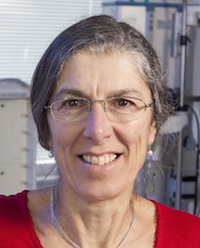The fifth ACM SIGCHI Symposium on
Engineering Interactive Computing Systems
City University London, UK, June 24–27, 2013
Keynote Speakers
The EICS program committee is pleased to welcome our distinguished keynote speakers, Jeffrey Nichols, Ann Blandford and Pat Healey
Jeffrey Nichols

Using the Crowd to Understand and Adapt User Interfaces
Engineering user interfaces has long implied careful design carried out using formal methods applied by human experts and automated systems. While these methods have advantages, especially for creating interfaces that have the flexibility to adapt to users and situations, they can also be time consuming, expensive, and there are relatively few experts able to apply them effectively. In particular, many engineering methods require the construction of one or more models, each of which can only be created through many hours of work by an expert. In this keynote, I will explore how social and human computation methods can be applied to reduce the barriers to achieving user interface flexibility and ultimately to using engineering methods. In a first example, I will illustrate how groups of users can work together to modify and improve user interfaces through end-user programming examples from the CoScripter and Highlight projects. I will then discuss some initial work on using a crowd of novice workers to create models of existing user interfaces. I hope this keynote will inspire the engineering community to consider alternate approaches that creatively combine formal methods with the power of crowds.
Biographical sketch: Jeffrey Nichols is a Research Staff Member and Manager of the Social Media & Crowd Research group at IBM Research – Almaden. He leads research efforts on crowdsourcing, social media analysis and social engagement. He joined IBM in 2006 after receiving his Ph.D. from the Human-Computer Interaction Institute in Carnegie Mellon University’s School of Computer Science. He has worked in the areas of mobile computing, automated design, and end-user programming. He is the author of more than 25 publications in academic conferences and journals, and co-edited the book No Code Required: Giving Users Tools to Transform the Web, published by Morgan Kaufmann in 2010. He is also the Information Director and an Associate Editor for ACM Transactions on Computer-Human Interaction (ToCHI), the premier journal in the field of human-computer interaction. He taught introductory human-computer interaction courses at the University of California, Berkeley in 2009 and 2010.
Ann Blandford

Engineering works: what is (and is not) “engineering” for interactive computer systems?
What does it mean to “engineer” an interactive computer system? Is it about the team doing the work (that they perceive themselves as engineers), about the process being followed, about the application domain, or something else? Is engineering about managing complexity, safety or reliability? For physical artifacts, it may be possible to achieve consensus on how well engineered a product is, but this is much more difficult for digital artifacts. In this talk, I will offer some perspectives, both positive and negative, on the nature of engineering for interactive computer systems and, at least implicitly, the nature and future of the EICS conference series. Does engineering work? This is a topic that merits discussion.
Biographical sketch: Ann Blandford is Professor of Human–Computer Interaction in the Department of Computer Science at University College London, and served as Director of UCL Interaction Centre (UCLIC) (2004-2011). She has a first degree in Maths (from Cambridge) and a PhD in Artificial Intelligence (from the Open University). She started her career in industry, as a software engineer, but soon moved back into academia, where she developed a focus on the use and usability of computer systems. Ann leads research projects on safety-critical systems and on interacting with information, with a focus on modelling situated interactions. In particular, she leads an EPSRC Platform Grant on Interactive Systems in Healthcare, and an EPSRC Programme Grant, CHI+MED, on Human–Computer Interaction for Medical Devices. She has over 170 publications in international, peer-reviewed journals and conference proceedings. She has been Chair of the BCS/CPHC Distinguished Dissertations Committee (2010 & 2011) She has been technical programme chair for IHM-HCI 2001, HCI 2006, DSVIS 2006 and NordiCHI2010. She chaired AISB (1997-1999), and was a member of the EPSRC ICT Strategic Advisory Team (2004-2008). She is a Fellow of the BCS and a Chartered Engineer.
Pat Healey

Design for Human Interaction: Communication as a special case of misunderstanding
“The killer application of the internet is other people” (Kang, 2002). In this talk I will argue that in order to engineer effective and usable interactive computing systems we need to consider not just the human-system interface but the human-human interface. Specifically, I will argue that human-human interaction is organised in ways that can be critical to the usability and effectiveness of many technologies but are typically overlooked by approaches that focus primarily on human-system interface. The source of this problem is an individualistic model of human interaction that fails to recognise the role of specialised inter-individual processes in communication. Human communication, I will argue, is best characterised as a continual, collaborative process of detecting and recovering from misunderstandings using whatever resources are to hand. Contemporary technologies typically impede these processes making effective co-ordination more difficult. However, if we attend directly to these critical moments in human interaction we could significantly improve the design and evaluation of many interactive systems.
Biographical sketch: Pat Healey is Professor of Human Interaction and leader of the Cognitive Science Research Group at Queen Mary University of London. He also Co-directs the Media and Arts Technology Programme, a UK government sponsored Doctoral Training Centre. He trained in Behavioural Science at the University of Nottingham and subsequently in Cognitive Science (MSc and PhD) at the University of Edinburgh. His research interests focus on developing novel technologies for enriching and extending human interaction.
